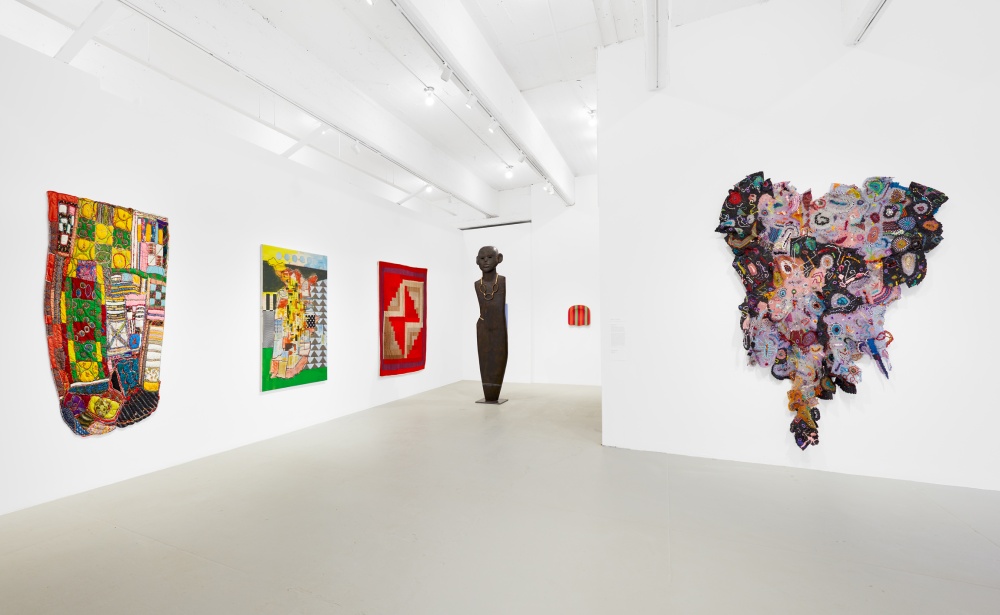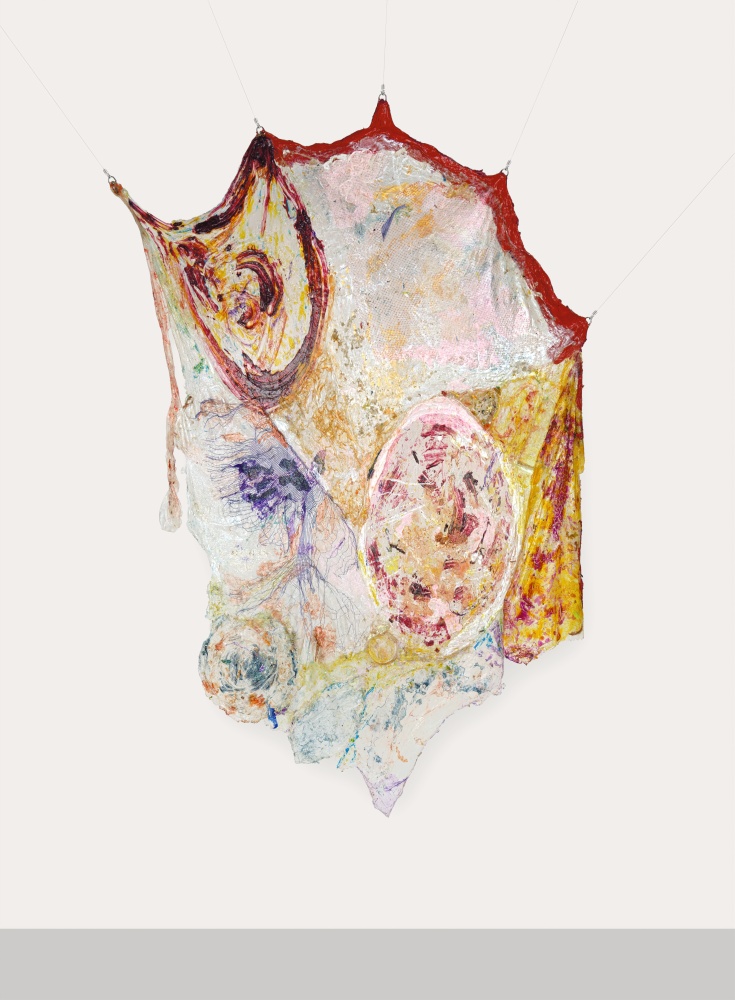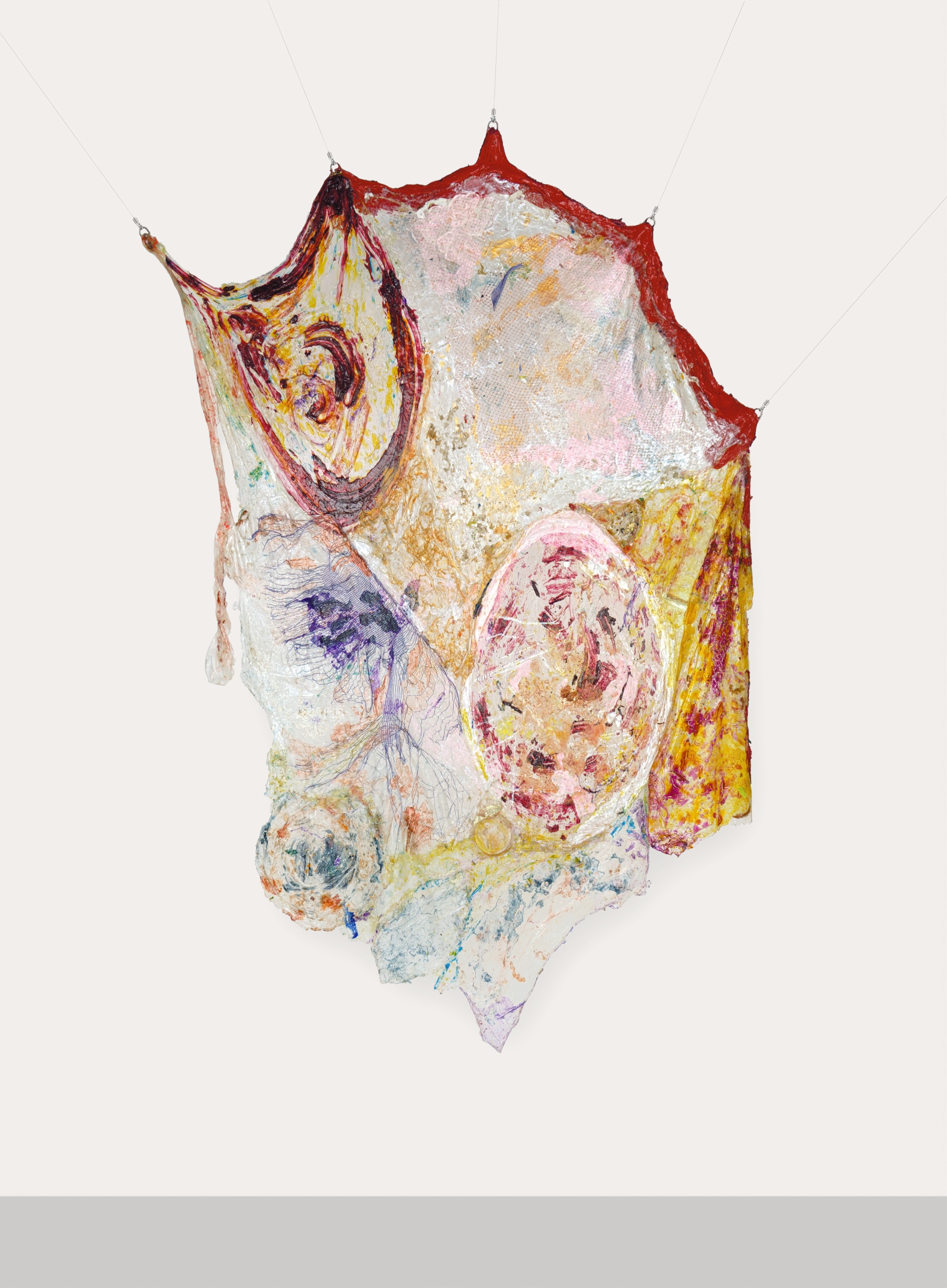Editor’s Note: As part of our editorial work to place contemporary art practice in conversation with our archives, we’ve paired Virginia Canella’s piece on the mark-making techniques of women in contemporary art with a 2012 essay by Elsye Speaks exploring Lee Bontecou’s experimental sculptural technique—The Terms of Craft and Other Means of Making: Lee Bontecou’s Hybrid Trajectory—published in Art Journal 71, no. 4, Winter 2012).
Pedagogies features critical perspectives on teaching and learning where educators share their personal strategies in the classroom, historians consider histories of art education; and artists produce pedagogically inspired artworks.
A brightly lit garage space on West 22nd Street, in the Chelsea neighborhood of Manhattan, was my refuge from the wind tunnel that is 11th Avenue. The unassuming warehouse lured me inside with more than just the promise of shelter. It opened into a compelling sprawl of artwork that I soon learned was an exhibtion hosted by the Shah Garg Foundation1 titled Making Their Mark, curated by Cecilia Alemani (November 2, 2023–March 23, 2024). Maybe I read the exhibition title wrong at first in my shivering state, but I understood the show to be about literal mark-making, in the uniquely feminine ways that it showcased.

The reshaping of Western art history to expand beyond the boundaries of wealthy, white, male art has reached refreshing new heights, with artists, educators, and collectors from marginalized groups gaining self-granted agency and courageously creating worlds of opportunity for themselves and their own communities—precisely what Komal Shah, co-founder of the Shah Garg Foundation has set out to achieve with her collection and the exhibition of it in an accessible public space, as well as the appointment of Alemani as curator of the foundation’s New York exhibition.2
In addressing the exclusive and oppressive history of institutional exhibitions of fine art, curators must carefully consider new and emerging views on the state of contemporary art and how works of art from the past few centuries have been defined up to now, as they pertain to the ways in which women artists have been and are still under-recognized for their contributions. Making Their Mark represents a cultural shift seen in the approaches of many contemporary gallerists today—from LaiSun Keane in Boston, who shows only work by women and minority artists to Antwaun Sargent’s appointment as a director at Gagosian, representing Black artists exclusively.3 In order to create a new mainstream in which artists of all backgrounds are presented with equal opportunities to achieve their definitions of success, these underrepresented groups must assert themselves in ways that have become conventional for white, male artists—meaning, establishing exhibitions, organizations, and collections that exist for the purpose of gaining said equal representation. This was the first “women’s” exhibition I have been to that I felt had genuine intent. Museum displays of “women artists from the collection” often feel like tone-deaf responses to complaints of underrepresentation. While larger institutions should respond to valid criticisms of their historic tendency to showcase marginalized artists less frequently than others, many have not figured out how to make this effort meaningful, with viewers and scholars alike often noting that these tailored exhibitions can be centered around reductive themes.4
Making Their Mark did not feel this way. The show stayed with me throughout the day, long after I had left the warehouse-sized beacon of a gallery. One might conclude from the foundation’s general claim to elevate art created by women, that this exhibition would fall under the same trivial umbrella as others that have come before, claiming to be special due solely to the fact that it features exclusively women. I would argue that there is something inherently special about these spaces—our fierce, collective ownership of our labor, bodies, and ideas is how we progress—yet, intention must deliberately be present for “women’s exhibitions” to have the success they hope to achieve. Shah and Alemani, by pairing significant artworks created by notable women artists of the twentieth century with those of ultra-contemporary emerging women artists, claimed to be “envisioning art history as a field of sympathies and attractions that subvert traditional narratives and accepted hierarchies.”5 I did feel this direct opposition to tradition, and I recognized an underlying curatorial motivation of showcasing mark-making by women—the way our hands move, the way we leave traces of ourselves in our art, the way our marks share an unspoken yet interconnected language. This connection between the work unlocked something I had not yet realized about my own formal arts training in higher education. And I should remember, having only graduated a few months ago.
I could not recall any women artists in history or in contemporary artistic movements that my college’s curriculum, or my professors, referenced for their “mark-making.”
As an emerging curator myself, immersed in the intersection of curation and art education and all that can be taught through conceptual exhibitions, I immediately think of what must have been missing from my own education to have the material in Making Their Mark feel united by a new, unfamiliar perspective. I realized that I could not recall any women artists in history or in contemporary artistic movements that my college’s curriculum, or my professors, referenced for their “mark-making.” Arriving to my foundation year of college as the product of an underfunded, indistinct public high school art program, the concept of mark-making was brand new to me—that is, I didn’t have the academic terminology for what I had been practicing on my bedroom painting set for years prior. Thus, packaged and delivered to me as the unachievable, intuitive-for-the-select-few method of line creation and color construction, mark-making in my own artwork dwindled from my natural ways of moving my pencil and strove to mimic that of the male artist’s work displayed on the screen for the freshman class to gasp over. I stood at my easel, instructed by professors to swing my arms every which way with my charcoal in hand, evaluated on if I could be as loose as someone like Christopher Wool. If only I had understood that mark-making is innate, and is something that is celebrated for its innateness, and not for how well it replicates those who came before. This is the achievement of Making Their Mark. It is a showcase of not only the significant innovations of women artists’ names that we recognize, Segunda Negundi and Joan Semmel, say, but the deliberate conversation between these works and those of the defiant, fierce, pioneering contemporary mark-makers like Jadé Fadojutimi and Christina Quarles.
How can the expansion of mark-making be understood to encompass the common language women artists communicate through their painted washes of color, knotting of threads, stitching of fabric, adhering thin planes of plastic, pressing clay between palms?
How can the expansion of mark-making be understood to encompass the common language women artists communicate through their painted washes of color, knotting of threads, stitching of fabric, adhering thin planes of plastic, pressing clay between palms? My formal studio arts training left me with extensive knowledge of the blurry brush strokes of the Impressionists, the gestural pastels and harsh ink lines of Cy Twombly, the wildly abstract paint splatters of Jackson Pollock. Mark-making innovators, we were told. The deliberately off-center registration that defined Andy Warhol’s iconic screen printing style was described as “mark-making” to us. Willem De Kooning, Frank Bowling, and others were revered by professors for the mark-making that created Abstract Expressionism. Helen Frankenthaler was sometimes mentioned in the same breath as these “greats,” but she was not a mark-maker—she was an experimenter, as if to say that women artists could not deliberately move their paintbrush, and could not make intentional contributions to a larger artistic movement.
Women included in the Shah Garg Collection exhibition were, like Frankenthaler, no doubt discussed in my college courses. I currently have a woven tapestry acting as a table runner in my new apartment that I created with the leno lace technique after my weaving professor introduced our class to Lenore Tawney, whose Inquisition hangs in the first-floor corner of Making Their Mark. When creating my own explicit, storytelling tufted tapestries, an interdisciplinary studio professor encouraged me to research the Slave Rape Series by Faith Ringgold,6 whose pieces Window of the Wedding #3: Woman and Window of the Wedding #4: Man were installed in the first hallway of the show. Although these women artists and many others were either briefly mentioned by my male professors or extensively discussed by my female professors, the words “mark-making” were never associated with their artistic practices. Making Their Mark leaves me wondering why. The selected works of these ninety-six significant women artists have an intuitive and radiant mark-making language that they share with one another. I believe this is what has enhanced their connection to each other, therefore allowing collectors, curators, and viewers to better understand what is so enticing and intimidating about this collection of women’s art.
These are the marks that communicate a shared sense of sweetness in the harsh, tenderness in the cold, hopefulness in the dismal . . .

A connection that should be highlighted, celebrated, studied, expanded, discussed, understood: the exposed tears of paper and tape in Sarah Sze’s Crisscross, the symmetric and calculated sections of sewing in Quinnie Pettway’s Quilt in “Bricklayer” variation and Freedom Quilting Bee’s Patterns to Joseph’s Coat, the meticulous sculptural beading of Joyce J. Scott’s Harriet’s Quilt. These are the marks that are universal to us, these are the marks that communicate a shared sense of sweetness in the harsh, tenderness in the cold, hopefulness in the dismal—concepts and actions that are innately human, but their expression is often specifically feminine.

Is it so radical to define a movement of mark-making specific to women? Or can this only exist in distant art history for men to forever be referred to? We are inspired by these motions and methods of creation—we always have been and we always will be. The difference is naming them and categorizing them so that they will be properly remembered by artists and historians for years to come. Male artists have benefited from this privilege for centuries. Making Their Mark, a showcase of artworks by women who have propelled the art world forward throughout the past century, has the potential to reserve both past and future artistic social movements for women to lead. There is a unique potential of discovery in creating these all-women spaces for the arts: not only in providing rightful representation and appreciation of contributions made by women to the greater culture, but in the simplicity of inviting us to exist, inviting us to experience these contributions on a grand scale, all at once.
Mark-making, a foundational idea of the artistic process, has in my own mind admittedly been something solely attributable to men’s work throughout art history. I’ve never been told otherwise, until this revelation brought on by Making Their Mark. I’ve not adequately valued the way the documentation of my own hands’ movement takes its form in my art. The artwork that I have viewed throughout my life and the work I continue to look to now feels like I am re-experiencing it through the lens of a clearer connection: one embedded with full attention to the care shared by women expressed to themselves, to their heritage, to each other, and to everyone.
I stare at my hand-tufted textile piece hanging above my desk that my partner encouraged me to display in our apartment’s shared workspace. I recognize each loop of yarn, and remember the ripe strain my fingers felt as they put the punch-needle into motion, and the deep ache of my lower back after standing for hours on end to support my homemade tufting frame. These marks last on my body internally, and my mark-making lasts physically, externally, full of me.
Virginia Cannella is a curator and educator living in Brooklyn. Her practice involves socially engaged pedagogy and culturally responsive public programming. She earned a BFA in Art Education from Mass Art in Boston. She has curated exhibitions and shown artwork at Abigail Ogilvy Gallery, Gallery263, and Piano Craft Gallery, which held her solo exhibition To Hold and To Hold Often in December 2023.
- The foundation was created to support women artists and engage the public with women’s innovation through art. ↩
- Hilarie M. Sheets, “Komal Shah, Champion of Female Artists, Works to Raise Their Profiles,” New York Times, March 22, 2023. ↩
- Nate Freeman, “Inside Antwaun Sargent’s Hyperspeed Art-World Ascent,” Vanity Fair, November 21, 2022. ↩
- Ria Goveas, “Women Take the Floor at the MFA—Progress or Division?,” The Wellesley News, October 13, 2021. ↩
- Making Their Mark: Works from the Shah Garg Collection, exhibition brochure. ↩
- Vivien Green Fryd, “Faith Ringgold: Quilting the Anti-Rape and Anti-Incest Cycle, 1972–1986,” in Against Our Will: Sexual Trauma in American Art Since 1970 (University Park: Penn State University Press, 2019), 106–13. ↩

